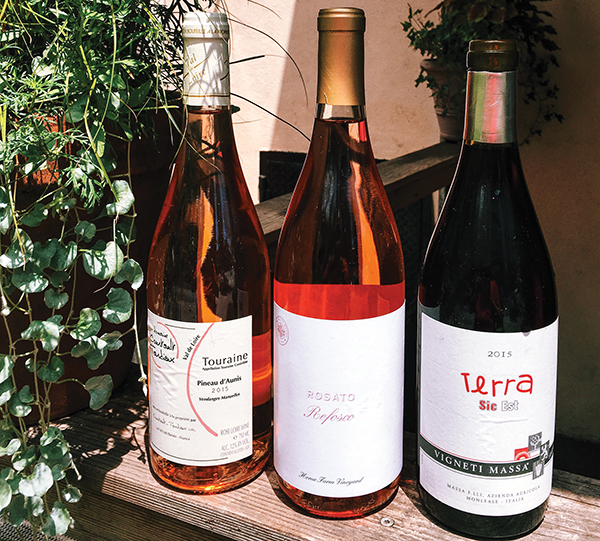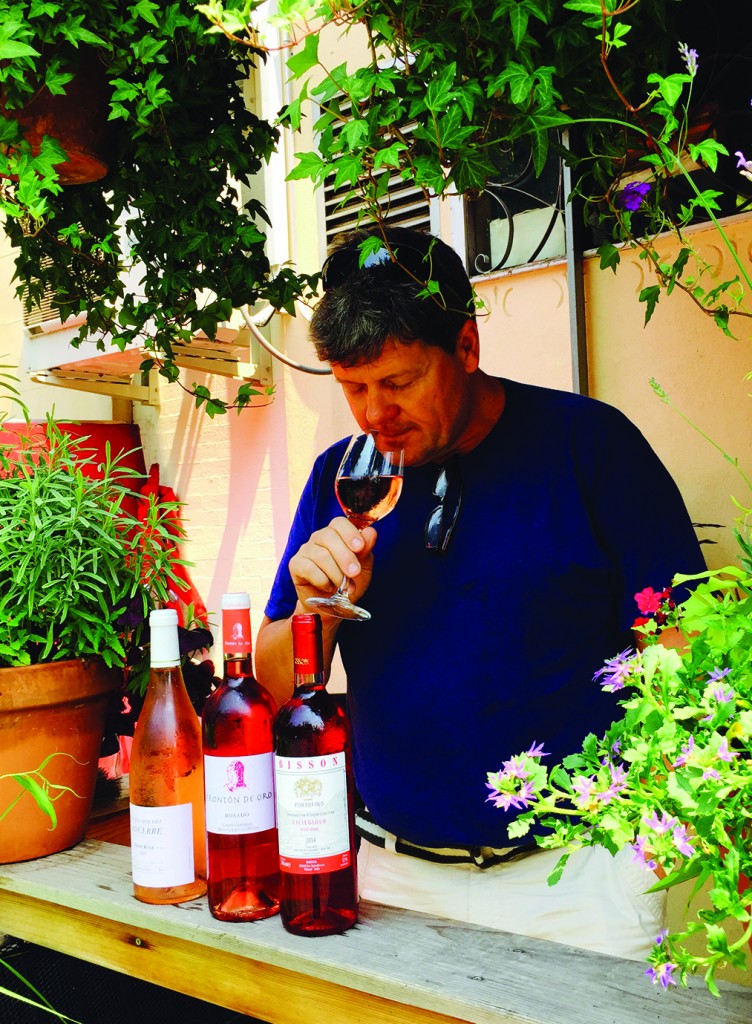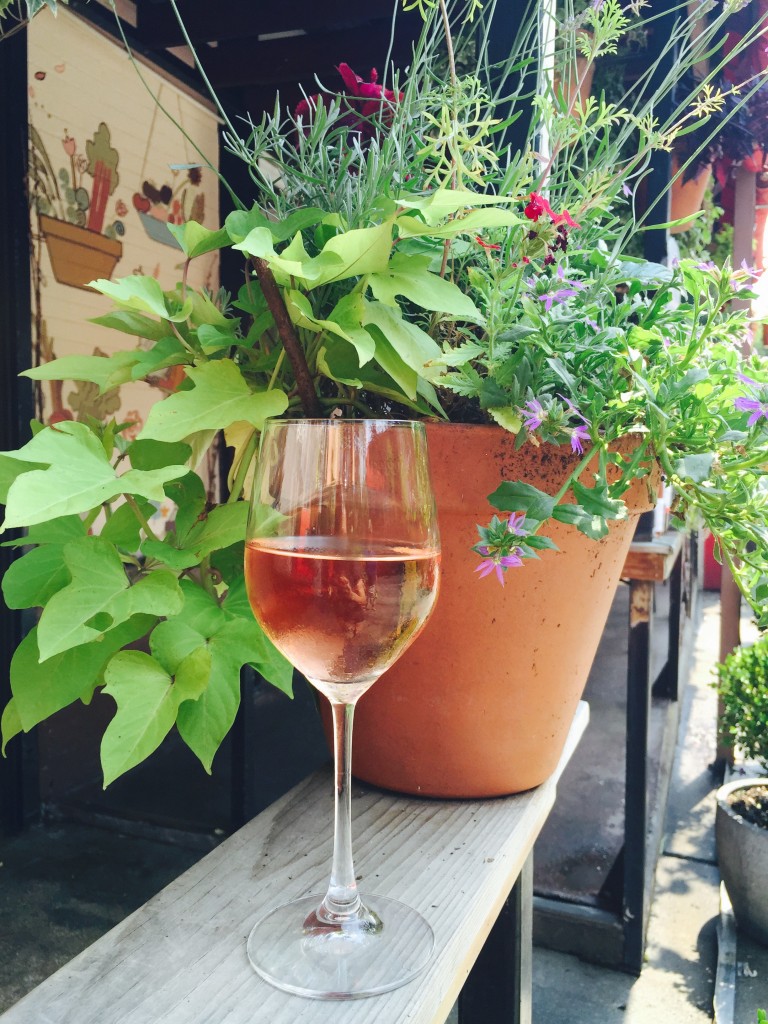Rosé has been a passion and a warm weather standard for us at Rose Water since the day we opened in August of 2000, (and a bit of a namesake, too, really). Its delicious, refreshing, and for a seasonal restaurant like ours, what other wine speaks to it’s season better than rosé? Nothing makes us happier than cold, delicious pink wine on a warm summer night. Now that Summer 2016 is in full swing, it’s time to sample a few of this year’s favorites from the 2015 vintage.

Rosé is made from red grapes (although sometimes by blending white and red to get pink, but purists generally frown upon this practice). Red wine gets its color when the clear juice of red grapes spends weeks or months in contact with the grape skins. Rosé, on the other hand, usually spends only hours on those red grape skins before the juice is pumped off to a fermentation tank. Thus the much lighter hue and lighter body, while retaining some of the savory character and spice we love in red wine, along with the some of the best aspects of white – freshness and a pronounced minerality.
In a recent column we wrote about heirloom grapes and the interesting and diverse wines they produce. One of our favorite heirloom varietals is Pineau d’Aunis, a red grape grown primarily around Anjou and Touraine in the Loire Valley in Western France. It’s a delightful, but thin-skinned and fickle grape that almost became extinct in the last century, primarily due to low crop yields and its susceptibility to mildew and pests. For natural winemakers who, as a rule, try to use little or no herbacides and pestacides, these grapes can be even harder to grow than they are for conventional growers. When a farmer faces hard economic choices, it can be tempting to rip out those unreliable heirloom vines and plant hardy, high-yielding Sauvignon Blanc, for example.
A couple years ago we we fell in love with a Pineau d’Aunis rosé from Domain Courtault-Tardieux in the Touraine, but there was very little produced that vintage and even less exported to the States, and it was gone in a flash (low yields, indeed). Courtualt-Tardieux actually does grow a lot of Sauvignon Blanc, which affords them a relatively consistent income so that they’re able to stick with a risky heirloom varietal that they see as vital part of the history of winemaking in their region. Thankfully, they’re completely committed to Pineau d’Aunis.
In January of 2015 we started working on getting the 2014 bottling, only to find out that a difficult vintage (vinegar flies!) meant there was no wine at all coming stateside last year. Zero. (Unreliable, indeed). But now the delightful 2015 vintage has finally arrived and it was worth the wait; light and rainwater fresh (great minerality from clay and limestone soils) with bright strawberry fruit and a little savory spice. Gorgeous now, but developing and coming into it’s own as each week passes – we’re going to lay aside a case for next summer to see how it matures. As usual, there isn’t much of this wine, but we managed to purchase a fair amount of what came to NYC, and we’re thrilled to be able to have it on our list (and usually by the glass) all summer long.
Courtault-Tardieux Pineau d’Aunis Rosé 2015. Available at Rose Water and Vine Wine, 616 Lorimer St. BK, www.vine-wine.com $15
Every year we offer at least one rosé from out east. In the past we’ve served delicious pinks from Shinn, Wolffer, Paumanok and others, but this year we were struck by the unique character of the Refosco from Channing Daughters Winery in Bridgehampton. Channing Daughters is tirelessly experimental and they are proud champions of lesser known varietals. They’re easily one of the most interesting wineries on Long Island.
In 2007 Channing Daughters acquired a three acre plot on the South Fork called the Home Farm Vineyard and planted two Italian varietals, Lagrein and Refosco. Refosco is native to the Friuli-Venezia-Giulia region in Northeastern Italy, and it produces primarily dark reds, most of which are not exported from Italy. Jancis Robinson describes the grape as producing reds that are “dense, lively wines with bite.” The Refosco grown by Channing Daughters has that density and bite, but in their rosé it’s delightfully restrained and the wine is unique and fascinating. With it’s balanced but bigger mouthfeel, brambly, smoky fruit and a little tannic grip, this wine is wonderful with heartier fare. We’re pairing this with grilled fish and fowl this summer and it’s divine.
Channing Daughters Winery Home Vineyard Refosco Rosato. At Rose Water and Michael Towne Wines, 73 Clark St. BK,
www.michaeltownewines.com $20
In southeastern Piemonte, Walter Massa produces an array of wonderful wines in the appellation of Colli Tortonesi. He likes to say he has five sons in his family: Barbera, Freisa, Nebbiolo, Croatina and Timorasso, an indigenous white heirloom grape that Walter is famous for having single-handedly revived and elevated. It’s those first two “sons,” Barbera and Freisa, that go into Walter’s rosato, Terra: Sic Est (translated loosely as Earth: what you see is what you get).
Massa’s 2015 rosato looks and drinks more like a light red than a simple pink quaffer, but it’s no less wonderful a drink for the season – we can’t imagine a better foil for a fatty steak or lamb chop hot off the backyard grill. It smells and tastes first and foremost of ripe, juicy cherries, but has a savory quality of subtle herbs and spice (mahleb) and just enough grip. And it’s remarkably fresh. A pink wine this red is not for everyone, but for us it completes the broad spectrum of the wonderful world of rosés we offer.
Vigneti Massa Rosato Terra: Sic Est 2015. At Rose Water and Flatiron Wines, 929 Broadway, NY, www.flatiron-wines.com $18
These are just three of our favorites so far this summer. We generally offer a dozen or so at any given time in the height of the season. We hope you can come by and enjoy one with us while the weather is warm, or stop by one of the fine retailers listed above. There’s no better way to celebrate the season with friends and family than sipping a chilly glass of delicious wine with the foods of summer.


